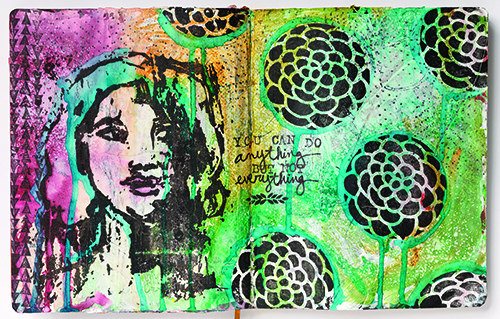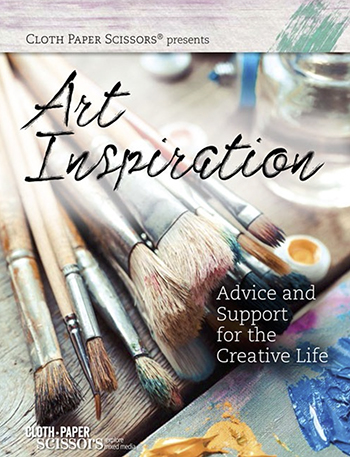Technique Tuesdays: 10 Tips for Finding Inspiration

You finally find time to head to your workspace, and then that horrible feeling hits—surrounded by a million supplies, nothing motivates you to create. Finding inspiration seems more difficult than crossing the Atlantic in a rowboat.
You may feel completely alone, but every single one of us has been there. Getting motivated to create isn’t difficult, but sometimes we just need a little push, a few ideas, to get us going in the right direction. Here are 10 tips that you can start to use right now, especially if your muse isn’t answering her texts:

1. Create every day. Sure, that sounds easy, but how can you create when you don’t feel inspired? The trick is to look at the situation the other way around: If you set aside time every day to do something—anything—it will form a creative habit. Take 15 minutes and scribble something on a piece of paper. Swipe some paint across a canvas. After a while, that habit will be difficult to break. You’ll look forward to the time set aside for making art, and you’ll have more ideas than you know what to do with. In the article “Collage a Day” in the November/December 2016 issue of Cloth Paper Scissors, Robyn McClendon writes about the benefits she reaped from challenging herself to create a collage a day for a year. She writes, “This 365-day project has made me more prolific, and I am never at a loss for ideas. Every day, every page, I have new creative inspiration, and by the end of the year I end up with 365 new ideas that generate more ideas.”

2. Make a list. Not everyone is a journaler, but journaling can be a wonderful catalyst to creating artwork. Dina Wakely loves making lists, which can be both cathartic and great springboards to artful inspiration. She offers some great list ideas in her book Art Journal Courage. “I used to be a technical writer,” she says, “and one of a technical writer’s favorite things is a bulleted list.” Lists, she adds, are easy to write, devoid of pressure to write long paragraphs, and offer instant satisfaction. Here are some of her list ideas, aptly presented with bullets, which are great creative prompts:
- Things That Made Me Happy Today
- Things I’m Grateful For Today
- Random Things About Today
- Ways I Was Enough Today
- Quiet Moments From Today
3. Get rid of some stuff. It’s practically heretical to ask artists to part with a portion of their supplies, tools, and materials. But how your workspace functions is a huge part of how you function as an artist. If your studio is overstuffed, that can stop your mojo dead in its tracks. Julie Fei-Fan Balzer offers this idea from the November/December 2012 issue of Cloth Paper Scissors: “Purge regularly. Yes, we are mixed-media artists, and yes, we can use almost anything to make art, but in order for your space to be a working studio and not a storage closet, it needs to be filled with things that you are actually using. If you can’t bear to throw away a certain something, consider donating it to a good home, or boxing it up and storing it away somewhere outside of your work space. Label the box with the date, and then if you haven’t gone looking for it in a year, get rid of it.”

4. Make mistakes. Often what keeps us from finding inspiration is the fear of making mistakes—even small ones. We don’t want to ruin what we’re working on. We don’t want to take a risk in case it doesn’t pay off. But Seth Apter says working through that fear can help us feel even more inspired. In the March/April 2015 issue of Cloth Paper Scissors, he writes, “Creativity is stifled when a person approaches any creative endeavor with a fear of doing something wrong. Options are removed and possibilities are taken away. There have been times when I have felt too intimidated by the fear of ruining a piece of art to allow myself to move on, though I knew that artwork was incomplete. This fear can sometimes hold me back from pushing my creative boundaries and stepping outside my comfort zone, which in turn can keep me from taking my art to the next level… Art is all about risk. Creativity should not be bound. Once you embrace mistakes, the door swings open and the possibilities are endless.”
5. Make time for play. Maybe you’ve set aside time for art on a consistent basis, but now you feel like that time must be spent doing something Important, like making the best art journal page of your life, or creating lettering so beautiful it would bring a grown man to tears. Nope. Just as spending time on actual projects is essential, so is play. Play takes away restrictions and eliminates deadlines and stretches your muscles like nothing else. In the book Creative Strength Training by Jane Dunnewold, contributor Sandy Kunkle describes how play makes her feel inspired to do more. She starts with a box full of fabric scraps backed with fusible adhesive and lays them on paper, ironing them down when she has a few rows. “Play really allowed me to move quickly into the zone and then I was lost in time,” she says. “As a super planner and organizer, this exercise told me that working intuitively can be freeing.”
6. Don’t always rely on the Internet. Searching for ideas on the web is great when you feel a lack of motivation—until you’re down that rabbit hole looking at everything ever created. Then comes the creative logjam when it comes time to actually making something—with all those great ideas, where to begin?. “There is such a thing as too much inspiration,” writes Tiffany Teske in the January/February 2012 issue of Cloth Paper Scissors. “While nursing my newborn around the clock, I could only read about techniques and view the work of others. I felt I was drowning in ideas I couldn’t express. I fell into a rut, paralyzed by all the possibilities.” Her solution? “Once I decided to work on just one technique, I became unstuck and could create again.”

7. Be inspired by what you love. Cathy Johnson offers this tip for finding sketching inspiration in her book Artist’s Sketchbook, but the idea can be used for any medium: “Find one thing a day that really captures your attention. Try to pick something you love, something that touches your heart and piques your curiosity. Do a quick sketch, and if you have more time, develop it more fully. I almost guarantee you will feel that you truly lived during that period of time; you will remember just that moment, however brief or long.” Don’t draw? Render what you choose however you like: collage it, write it down and use it as a prompt for an art journal page, or stitch it. By starting with something you already enjoy, you’re more apt to be inspired by it.
8. Copy that. Artists are told again and again to try something new, push the envelope, stretch their wings, and a number of other clichés. Julie Fei-Fan Balzer says that doesn’t always have to be the case, and her advice is especially helpful when you’re not finding inspiration anywhere: Copy yourself! “There’s no shame in recycling a good idea,” she writes in the May/June 2013 issue of Cloth Paper Scissors. “Some artists have had mighty good careers based on a single idea recycled over and over. If you’re stretched for time, go back to a piece of art you love and dissect why it’s awesome. Then go ahead and copy those parts of it, while allowing new ideas, impulses, and/or supplies into the mix.”
9. Work intuitively. Sometimes we’re in our heads so much that we can’t find our way out—we over-analyze every mark, paint stroke, and bit of ephemera we’re about to work with, until we feel anything but inspired to make art. By working intuitively, says Crystal Neubauer in her book The Art of Expressive Collage, we can let go of expectations and plans and just create. “When I sit down to work,” she writes, “bits and scraps and tattered remnants of old books and papers spread out before me, I am not conscious of anything outside that space…As I move the papers around, I am opening myself to hear, deep within, a voice, an affirmation, an internal nod.” We must learn to trust that internal voice in order to feel inspired.

10. Find a touch of nature. No matter where we are, adding a little bit of nature to our day can awaken our creative cells like nothing else—even a strong cup of coffee. Even if you don’t plan to draw a flower, sometimes just looking at one can be inspirational. If you can’t take a hike in the woods or a stroll on the beach, study a tree, a cloud formation, or a weed that’s pushing its way through a crack in the sidewalk. In her book Storytelling with Collage, Roxanne Evans Stout writes, “I love to go outside into my garden and collect a small arrangement of flowers or leaves. I will put these in a dish or water or just lay them out to dry, finding beauty in all of their stages. These arrangements give me a sense of belonging and connecting to the natural world, and they help me remember to always find beauty in the details.”
Feeling motivated to learn more about finding inspiration? These books and downloads may be just what you need to jump start your creativity:




















Join the Conversation!